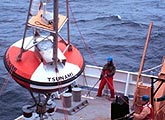Tsunamis and Southern California
Could a tsunami hit San Diego? Read about tsunamis and the warning systems in place in the Pacific Rim to save lives along our coastline.
Overview
A tsunami is a series of large waves of extremely long wavelength and period caused by a sudden underwater disturbance that displaces a large volume of water. Very large earthquakes with upward or downward movement, landslides, volcanic eruptions, and even meteorites are capable of generating a tsunami.
Southern California's low-lying coastline could experience tsunami waves, either from a distant event or locally generated by our own seismically active geology.
Distance from a tsunami's point of origin matters.
- Local or near-field tsunamis may be triggered when a major earthquake or underwater landslide occurs close to shore. The first wave in a series could reach the beach in a few minutes, with little to no time for warning systems to be effective. Areas less than 25 feet above sea level and within a mile of the shoreline are at greatest risk. Risks associated with a tsunami from a nearby event are expected to be low and limited in power, with maximum wave run-ups predicted to be approximately 20 feet or less.
(Note: If you feel a strong earthquake when you're in a low-lying coastal area or observe a rapid drop in sea level, immediately go to high ground or inland. Do not return to the beach until instructed that the potential danger has passed.) - Distant or far-field tsunamis originate hundreds or thousands of miles away from coastlines they may ultimately hit. While remotely generated waves can travel remarkably fast, time and distance enable tsunami warning centers to alert emergency personnel in the wave's projected path to begin evacuation. The ocean depth and islands along Southern California borderlands would act as a natural baffle to a tsunami wave generated from a remote earthquake.

Pacific Ocean tsunami warning systems:
The National Oceanic and Atmospheric Administration (NOAA) operates the existing tsunami warning system established by the Pacific Rim countries. Two tsunami warning centers are responsible for monitoring and warning U.S. coastal areas:
- The Pacific Tsunami Warning Center (PTWC) is responsible for tsunami warnings to international authorities, Hawaii, and U.S. territories within the Pacific basin.
- The West Coast/ Alaska Tsunami Warning Center (WC/ATWC) is responsible for tsunami warnings for California, Oregon, Washington, British Columbia, and Alaska.
Know the terms used by the WC/ATWC and PTWC:
- Advisory: An earthquake has occurred in the Pacific basin and might generate a tsunami. WC/ATWC and PTWC will issue hourly bulletins advising of the situation.
- Watch: A tsunami was or may have been generated, but is at least two hours' travel time to the area in Watch status.
- Warning: A tsunami was or may have been generated and could cause damage; therefore, people in the warned area are strongly advised to evacuate.
Within the WC/ATWC area of responsibility, a warning is issued to coastal areas for any coastal earthquake that has a magnitude of 7.1 or greater within 15 minutes after the earthquake occurs. The warning area surrounds the earthquake source. The Emergency Alert System (television and radio) and local law enforcement using bullhorns will order residents in warned areas to evacuate.
Resources:
- About Tsunamis, International Tsunami Information Center
- California Tsunami Inundation Maps by County
- Tsunamis, Federal Emergency Management Agency (FEMA)
- West Coast/ Alaska Tsunami Warning Center (WC/ATWC)
Special thanks to Dr. Neal Driscoll, Professor of the Geosciences Research Division at Scripps Institution of Oceanography, who contributed to this article.